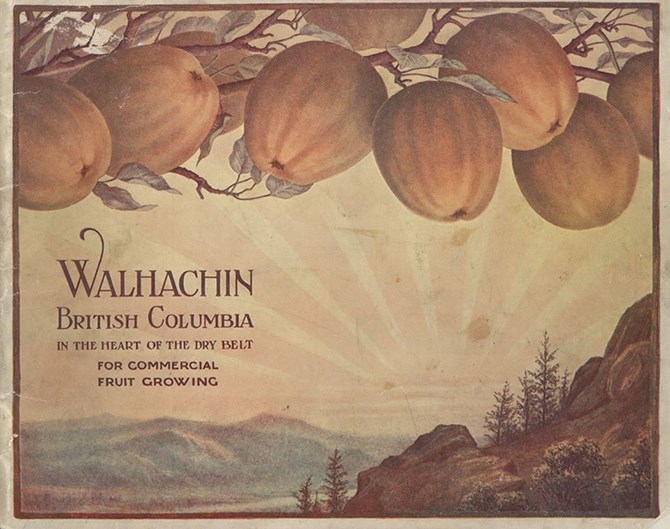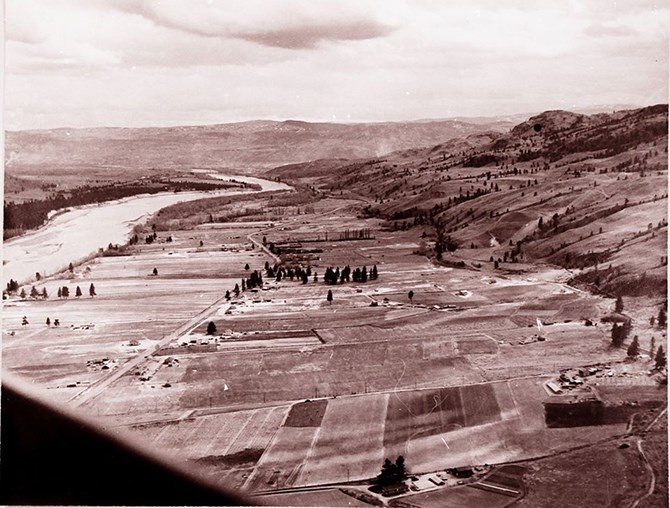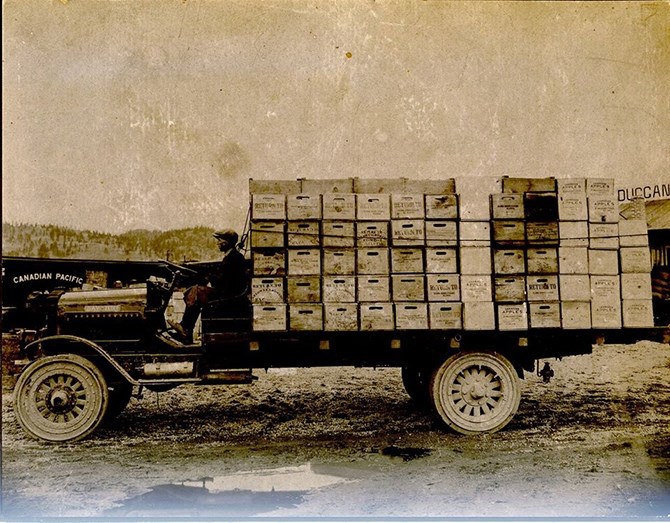
An early advertisement extolling the agricultural virtues of the Thomspon Valley community of Wallachin.
Image Credit: Facebook / Kamloops Museum and Archives
Republished June 09, 2020 - 3:30 PM
Original Publication Date June 06, 2020 - 3:00 PM
For years, Dave Geen has been growing cherries in the Central Okanagan.
His Coral Beach Farms has 850 acres of orchards in Lake Country, the largest individual cherry grower in Canada. But when he decided to expand again last year, he didn’t choose to plant in the Central, or even the South Okanagan where cherries and other soft tree-fruits are almost synonymous with the Okanagan.
For the first time, he added orchards in the Pritchard area east of Kamloops for another 150 acres. It might be a risk because he says the main difference between the two valleys is the moderating influence of Okanagan Lake.
“Historically, the Thompson is two to three degrees colder than the Okanagan in winter, but temperatures can vary in the Okanagan too. There is a series of microclimates in both valleys, where some are suitable for tree fruit and some not,” Geen says.
What difference can a large lake make? It keeps things warmer in the winter and cooler in the summer. Environment Canada weather data for Kelowna and Kamloops shows average January winter temperatures of -2 C to -8 C for Kamloops, and 1 C to -5 C for Kelowna.
In the summertime, the moderating effect is reversed. Kelowna’s average July temperature high and low at 28 C and 13 C, compared to 29 C and 15 C in Kamloops.
Geen says valley cloud formation in the winter, common in the Okanagan, is also a key aspect to controlling temperature.
Dieter Geesing, a regional agrologist at B.C.’s Ministry of Agriculture says there is no hard evidence today as to why there should be usage differences, why the Okanagan is synonymous with apples, soft tree fruits and more recently grapes, while the Thompson valley has its reputation in rangeland and ranching.
He concludes the only differences are historical and cultural, as certain agricultural activities began in each valley and were built on by newcomers. As infrastructure grew to handle their products, i.e, packing houses, cattle yards, etc., more of the same industry was attracted.

An early aerial view of Westsyde's Columbia Fruitlands irrigated land in the Thompson Valley.
Image Credit: Facebook / Kamloops Museum and Archives
Geesing says soil and temperature differences are minor, and both valleys have access to adequate water for irrigation.
“Probably someone growing tree fruits in the Thompson region today would do as well as someone in the Okanagan,” he concludes.
The history of agriculture was similar in the two valleys in the 1920s through the 1940s, as fruit and apple orchards boomed in both the Thompson and Okanagan, and experiments optimistically took place growing other crops such as tobacco.
Four thousand apple trees were planted in the Valleyview area near Kamloops in 1925. As far back as 1916, it was known that Thompson apples had a higher sugar content than those grown in the Okanagan, due to lower night temperatures in the Thompson.
But then, that "difference in degrees" kicked in.
The 1949-50 cold snap buckled the Thompson soft fruit industry at the same time the Okanagan received a fruit marketing boost, with the opening of the Hope-Princeton Highway. The coincidental events served to change perceptions — and realities — about the two valleys that have only recently been challenged.
In the Thompson, fully 75 per cent of the apple trees in the Brocklehurst orchard were killed that year, and Jimeva Farms, which hit a peak of 40,000 boxes of apples the previous year, was never productive again.
The falldown in production is obvious by today's crop comparisons. Data from the 2016 census indicates there were 8,610 acres of apples in the Okanagan compared to 159 acres in the Thompson, 4,201 acres of cherries in the Okanagan compared to 64 in the Thompson, and 1,199 acres of peaches in the Okanagan compared to 11 in the Thompson.
Pioneer agriculture began with cattle ranching in the Thompson, with the arrival of the Hudson’s Bay Company in 1846, followed by the first orchard in the Tranquille area in 1865.
It was a similar story in the Okanagan Valley, with the Haynes Ranch near Osoyoos and the O’Keefe Ranch near Vernon, but increasing pressure from orchardists, a glut in the meat market and over-grazing resulted in Okanagan ranches succumbing to development pressure in the late 1800s.

Okanagan apples bound for the Kelowna packinghouse in 1938.
Image Credit: Facebook / Oliver and District Heritage Society
Fruit farming didn’t come easily to the Okanagan. The first orchard fruit was exported from the valley in the 1890s, but poor transportation routes were a problem until the early 1900s, as was irrigation until the late 1910s and early 1920s, when sufficient capital to build more elaborate irrigation systems could be raised. With today's changing climate and perceptions of what each region can grow, it's starting to look like the future of the two valley's agricultural usage may well return to the parallel ways of the past.
Today, the Thompson is seeing new investment, not only in orchard crops but in grape growing as well.
Harper’s Trail Winery began growing grapes in the Thompson in 2008. The winery has 25.5 acres of grapes growing on their properties at 2761 Shuswap Road, roughly 18 kms east of Kamloops.
Harper’s grows seven varieties, including Pinot Noir and Cabernet Franc in their vineyard.
“We grow some pretty good riesling. We’re known for our riesling and our Cabernet Franc. Our mandate from the onset was to grow grapes that would be a true expression of the Thompson valley,” says owner Vicki Collett.
Collett says she believes there is a great future for wineries in the region.

The original house of the O'Keefe family near Vernon. The Thompson and Okanagan valleys share a pioneer heritage of ranching, but have since diverged agriculturally.
(BEN BULMER / iNFOnews.ca)
“Chances are really good it’s going to open up with more opportunities for vineyards and wineries in our area,” she says, noting land costs are also much cheaper than in the Okanagan. “We have a lot of the same risks the Okanagan has with frost. Once it gets cold, it gets cold. We’re more north, for sure, but I believe the risks are the same."
Kamloops Wineries Association Executive Director Trish Morelli called the area "ripe for explosion."
“I don’t know why more grape growers aren’t investing in the Thompson Valley where prices are so much lower than vineyard viable land in the Okanagan,” she said. “There are risks and grape varieties and locations must be chosen wisely, but that is no different than in the central and north Okanagan. Climate change has warmed things up here over the years. Our winters are not as consistently cold as they used to be and we know so much more about varietal clones and more winter hearty varietals."
Today there are 107 acres planted in grapes with six vineyards and four licensed wineries in the Thompson region.
"It may be true we are located on the 50th parallel, but with global warming, there's no difference between the Thompson and the Okanagan anymore," Morelli says.
— This story was originally published June 2, 2020.
To contact a reporter for this story, email Steve Arstad or call 250-488-3065 or email the editor. You can also submit photos, videos or news tips to tips@infonews.ca and be entered to win a monthly prize draw.
We welcome your comments and opinions on our stories but play nice. We won't censor or delete comments unless they contain off-topic statements or links, unnecessary vulgarity, false facts, spam or obviously fake profiles. If you have any concerns about what you see in comments, email the editor in the link above.
News from © iNFOnews, 2020